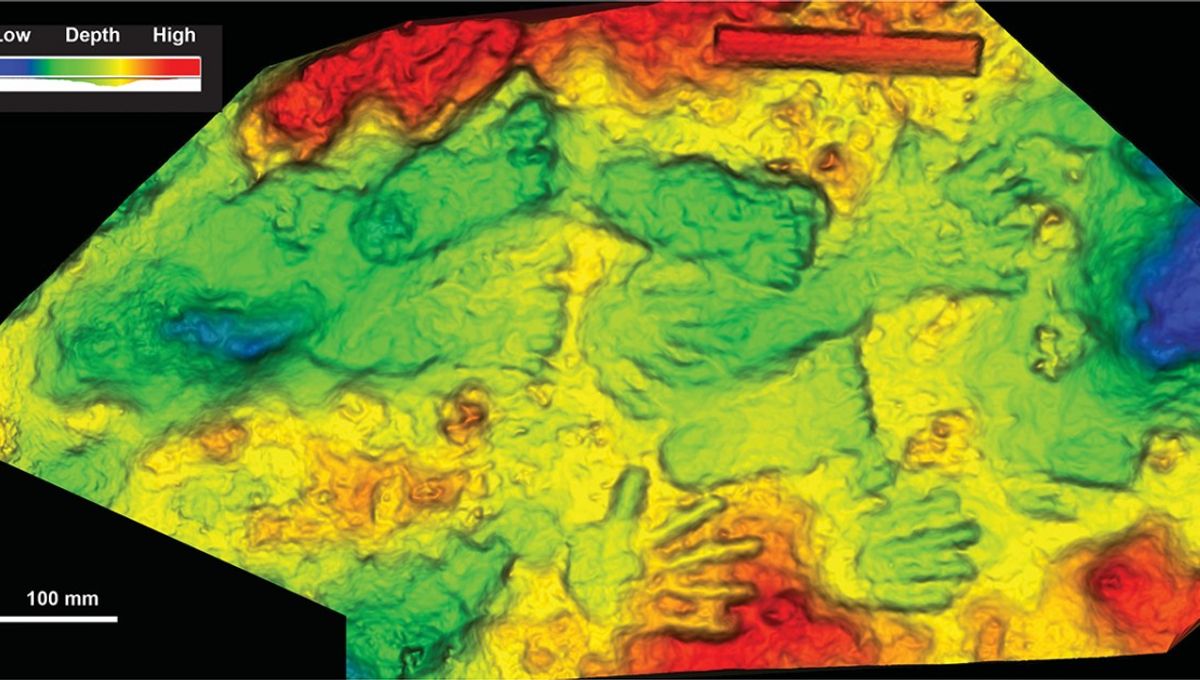
High up on the freezing Tibetan plateau, a pair of prehistoric hominid children created the world’s earliest rock art when they intentionally left their hand and footprints on a soft limestone wall about 200,000 years ago. At least, that’s the narrative that archaeologists proposed back in 2021, although a new analysis challenges this account and suggests that the prints are probably no older than 1,300 years old.
The picture of a primordial child artist in the Himalayas was initially painted in 2002, when researchers discovered a panel of prints near to the Qiusang Hot Springs in Tibet. Imprinted into a type of limestone called travertine before it hardened, the 18 impressions were dated to about 20,000 years ago using thermoluminescence analysis.
In 2018, the same researchers then found a second panel of prints at the same site. This time, they used uranium-thorium dating to determine the age of the artwork, with their results – published three years later – indicating that the markings were left between 169,000 and 226,00 years ago in the Middle Pleistocene.
Supposedly left by two children aged 7 and 12, the prints have been celebrated as the oldest example of parietal art on the planet, preceding other famous examples of hand and footprints in Indonesia and Spain by up to 185,000 years. In addition, the supposed age of the markings suggests that ancient hominid children were somehow living on the Tibetan plateau – often referred to as the Roof of the World – way back in the mid-Ice Age.
As wonderful as all that sounds, the authors of a new study have found a number of pretty massive holes in the plot. For instance, they point out that the use of uranium-thorium dating is highly controversial, and tends to provide results that are significantly higher than the age estimates given by radiocarbon dating.
Noting that the travertine panel is completely exposed to the elements, the researchers say that the removal of surface uranium by rainwater would certainly have increased the age estimate yielded by this technique. To account for this, the archaeologists behind the original claims should have analyzed the age of cores taken from deeper within the rock – something they neglected to do.
On top of this, the researchers say that the two panels of prints found at the Qiusang Hot Springs are virtually identical in both their content and their state of preservation, despite the fact that one is supposedly 20 times older than the other. This is something they find inexplicable, particularly when one considers that travertine is highly prone to weathering.
Yet the biggest flaw in the theory is exposed by the recent discovery of two Tibetan writing characters etched into the same panel of limestone. This writing system is thought to have been introduced around 1,300 years ago, and the inscriptions would have had to have been made just before the travertine hardened.
In other words, the panel on which the prints are found must have crystallized some time in the past 1,300 years, which means the markings left by the child artists can be no older than this.
Adding yet more skepticism to the mix, the study authors say that there is no archaeological evidence to support the presence of any human species on the Tibetan Plateau 200,000 years ago, and that the high altitude and freezing conditions would have made the region uninhabitable. “The area would have been subjected to either glacial or periglacial hypoxic conditions and would have been most marginal or inaccessible to Lower Palaeolithic hominins,” write the researchers.
“Bearing in mind that the earliest proposed human presence on the central Tibetan Plateau, attributed to the Nwya Devu site, is of the Final Pleistocene… [the] claim that Middle Pleistocene children lived at the Qiusang site during a glacial is extraordinary,” they continue.
Summing up their arguments, the authors conclude that this “extraordinary claim is made simply on the strength of dates derived from a method that is contentious when applied to travertine fully exposed to precipitation.”
Offering an alternative hypothesis, they propose that “the hand and footprints… were made at the same time as Tibetan inscriptions, no earlier than 1,300 years ago, because both were made in the still-soft precipitate.”
The study is published in the Journal of Archaeological Science.
Source Link: Prehistoric Children’s Handprints In Tibet May Not Be World’s Oldest Art After All